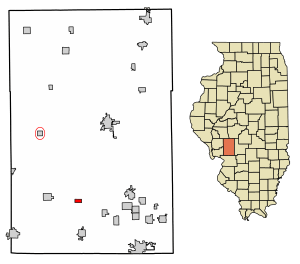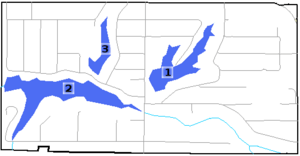Royal Lakes, Illinois facts for kids
Quick facts for kids
Royal Lakes, Illinois
|
|
|---|---|

Location in Macoupin County, Illinois
|
|
| Country | United States |
| State | Illinois |
| County | Macoupin |
| Township | Hillyard |
| Area | |
| • Total | 0.51 sq mi (1.33 km2) |
| • Land | 0.47 sq mi (1.21 km2) |
| • Water | 0.05 sq mi (0.12 km2) |
| Elevation | 640 ft (200 m) |
| Population
(2020)
|
|
| • Total | 167 |
| • Density | 358.37/sq mi (138.49/km2) |
| Time zone | UTC-6 (CST) |
| • Summer (DST) | UTC-5 (CDT) |
| ZIP code |
62685
|
| Area code(s) | 618 |
| FIPS code | 17-66196 |
Royal Lakes is a small village located in Macoupin County, Illinois, in the United States. In 2020, about 167 people lived there. This number was a bit lower than in 2010, when 197 people lived in the village.
Contents
Where is Royal Lakes Located?
Royal Lakes is found in Hillyard Township, which is in the southern part of Macoupin County. It sits where two main roads, Illinois Route 16 and Illinois Route 159, meet.
The village is about 45 miles (72 km) southwest of St. Louis. It is also about 60 miles (97 km) northeast of Springfield, the capital city of Illinois.
Land and Water Area
Royal Lakes covers a total area of about 0.51 square miles (1.32 square kilometers). Most of this area, about 0.47 square miles (1.22 square kilometers), is land. The rest, about 0.05 square miles (0.13 square kilometers), is water.
The Lakes of Royal Lakes
Three small lakes are found within the village of Royal Lakes. Their names are Meshach, Shad, and Shadrach. These lakes are important for the community.
- Meshach Lake is in the east-central part of the village. It is the deepest of the three lakes, usually between 9 and 12 feet deep.
- Shad Lake is about 1.5 acres (0.61 hectares) in size. It is quite shallow, with a maximum depth of only 2 feet.
- Shadrach Lake is located north of Magnolia Drive. Its depth can be from 5 to 8 feet.
Shad Lake is part of Coop Branch, which flows into Macoupin Creek. Meshach and Shadrach Lakes are also connected to Coop Branch through other small streams. All the water in Royal Lakes eventually flows into the Illinois River.
The History of Royal Lakes
The land where Royal Lakes now stands was bought in 1956 by a developer from Chicago. The plan was to create a resort-style community. This area was about 320 acres (1.3 square kilometers) in size.
Building a Resort Community
The three small lakes – Meshach, Shad, and Shadrach – were built for fun activities like fishing and boating. The rest of the land was divided into many small lots, each about 25 by 125 feet. Royal Lakes was promoted as a place where people could enjoy a rural resort at an affordable price. It was especially advertised in African American neighborhoods in St. Louis and East St. Louis. The first families moved to Royal Lakes in 1957. A community church was started in 1961, and its building was completed seven years later.
Becoming an Official Village
Because Royal Lakes was first seen as a "resort" area, there were no rules about how the land should be used. This meant the developer did not have to provide basic services. There was no proper road maintenance, water supply, or sewage system. This caused problems for the people living there.
By the early 1970s, residents realized that the best way to fix these issues was for the community to become an official village. An election was held in October 1972. Out of 98 votes, 89 people voted for Royal Lakes to become a village, and 9 voted against it. This is how Royal Lakes officially became the Village of Royal Lakes.
The village's first mayor, Thomas J. Stoddard, and other government officials started their work in April 1973.
Population Changes in Royal Lakes
| Historical population | |||
|---|---|---|---|
| Census | Pop. | %± | |
| 1980 | 270 | — | |
| 1990 | 272 | 0.7% | |
| 2000 | 190 | −30.1% | |
| 2010 | 197 | 3.7% | |
| 2020 | 167 | −15.2% | |
| U.S. Decennial Census | |||
The number of people living in Royal Lakes has changed over the years. In 1980, there were 270 residents, and this number stayed similar in 1990 with 272. By 2000, the population dropped to 190. It increased slightly to 197 in 2010 but then decreased to 167 in 2020.
Who Lives in Royal Lakes?
The table below shows the different groups of people living in Royal Lakes over time.
| Race / Ethnicity (NH = Non-Hispanic) | Pop 2000 | Pop 2010 | Pop 2020 | % 2000 | % 2010 | % 2020 |
|---|---|---|---|---|---|---|
| White alone (NH) | 30 | 62 | 68 | 15.79% | 31.47% | 40.72% |
| Black or African American alone (NH) | 153 | 127 | 85 | 80.53% | 64.47% | 50.90% |
| Native American or Alaska Native alone (NH) | 1 | 1 | 3 | 0.53% | 0.51% | 1.80% |
| Asian alone (NH) | 0 | 1 | 0 | 0.00% | 0.51% | 0.00% |
| Native Hawaiian or Pacific Islander alone (NH) | 0 | 0 | 0 | 0.00% | 0.00% | 0.00% |
| Other race alone (NH) | 0 | 0 | 0 | 0.00% | 0.00% | 0.00% |
| Mixed race or Multiracial (NH) | 4 | 1 | 10 | 2.11% | 0.51% | 5.99% |
| Hispanic or Latino (any race) | 2 | 5 | 1 | 1.05% | 2.54% | 0.60% |
| Total | 190 | 197 | 167 | 100.00% | 100.00% | 100.00% |
Education in Royal Lakes
Children in Royal Lakes attend schools in two different public school districts.
- If you live east of Julian Avenue, you are part of the Bunker Hill Community Unit School District 8.
- If you live west of Julian Avenue, you are part of the Southwestern Community Unit School District 9.
See also
 In Spanish: Royal Lakes (Illinois) para niños
In Spanish: Royal Lakes (Illinois) para niños



